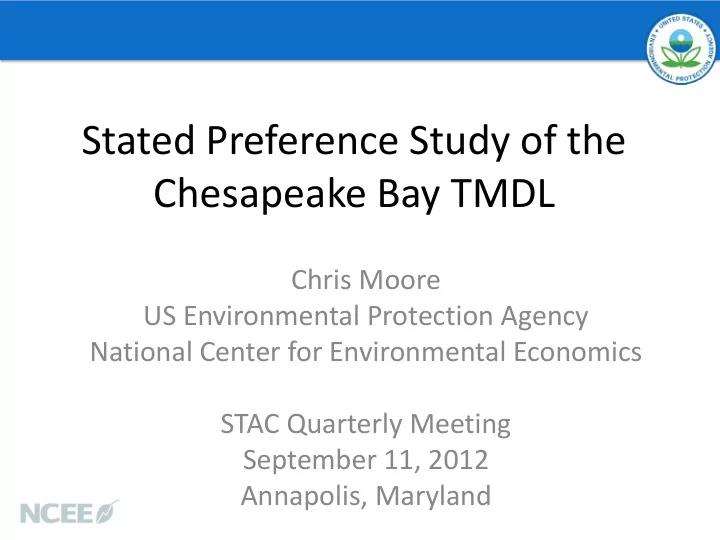

Stated Preference Study of the Chesapeake Bay TMDL Chris Moore US Environmental Protection Agency National Center for Environmental Economics STAC Quarterly Meeting September 11, 2012 Annapolis, Maryland
Project Team EPA - NCEE Consultants Chris Moore Maureen Cropper (RFF) Chris Dockins Alan Krupnick (RFF) Nathalie Simon Elena Besedin (Abt Assoc.) Kelly Maguire Dennis Guignet Peer Reviewers Rob Johnston (Clark U.) Kevin Boyle (VA Tech) John Whitehead (Appalachian State) Preliminary and subject to change 2
Stated & Revealed Preference • Revealed preference valuation methods rely on observable behavior to infer peoples’ willingness to pay (WTP) for environmental amenities – Travel cost – Hedonic property value • Stated preference methods rely on answers to carefully constructed surveys to estimate WTP – Contingent valuation – Choice experiment • EPA’s benefits study of the Chesapeake Bay TMDLs employs both types of nonmarket approaches plus market based analyses. Preliminary and subject to change 3
Why conduct a stated preference study? • Stated preference is the only way to capture “nonuse” or “existence” value • Existence values arise when people care about the condition of a resource whether they use it or not • The motivation could be – A sense of stewardship for the resource – Preservation of the resource for future generations – The option to use the resource in the future • Existence values are valid for use in benefit cost analysis and can be a significant fraction of total benefits (e.g. Smith 1987, Kopp 1992, Loomis 1996) • Several features of the Chesapeake Bay suggest existence values could be important in an analysis of the TMDL Preliminary and subject to change 4
Best practice in survey development • Draw on peer reviewed literature • Conduct focus groups and cognitive interviews – 10 focus groups and 40 interviews within and outside the watershed – Identify most salient policy outcomes for valuation questions – Test information treatment for completeness and clarity • Design survey to allow validity testing and identification of protest responses, scenario rejection, etc. • Small scale pretest of survey and data collection surveying full sample • Conduct peer review of study design – Three leading experts in stated preference wrote peer review reports on the survey instrument, sampling plan, and analysis plan Preliminary and subject to change 5
Key elements of the study design • Survey Mode: Mail survey following Dillman’s method • Sample Frame and Stratification – Maryland, Virginia and Washington DC – Other watershed states – Other east coast states • Policy outcomes in valuation questions (based on focus groups and interviews) – Water clarity – Striped bass – Blue crab – Oysters – Algae levels in lakes (related to clarity, appearance, and fish types) Preliminary and subject to change 6
Example of a choice experiment question Conditions in 2025 ( % change com pared to today) Environm ental No Additional Program A Program B Outcom es Action W ater Clarity 4 feet 5 feet 6 feet (33% increase) (67% increase) (100% increase) Average visibility Striped Bass 2 6 million fish 3 0 million fish 3 5 million fish (25% increase) (46% increase) Population (8% increase) Blue Crab 2 6 0 million crabs 2 8 0 million crabs 3 4 0 million crabs (4% increase) (12% increase) (36% increase) Population 4 ,3 0 0 tons 4 ,3 0 0 tons 5 ,2 5 0 tons Oysters Abundance (30% increase) (30% increase) (59% increase) Lakes 5 8 % 5 8 % 7 4 % Percent with low or moderate algae Cost of Living $ 1 8 0 every year $ 5 0 0 every year Permanent cost $ 0 every year or $15 every or $41.67 every increase for your month month Household No Further Action Program A Program B Your Vote Please mark one of the boxes to the right Preliminary and subject to change 7
Water quality and ecological projections • Chesapeake Bay Watershed Model – Nutrient and sediment loadings to the Bay – Nutrient loadings to lakes of the watershed – Water clarity in the Bay • Northeast Lakes Model – Nutrient and chlorophyll-a concentrations – Trophic states • Chesapeake Bay Fisheries Ecosystem Model – Relative changes in biomass for 3 chosen species Preliminary and subject to change 8
Valuing environmental changes • Random Utility Model (RUM) – Utility theoretic framework for analyzing stated preference data – A person’s choice is a function of observable characteristics, policy outcomes and cost, plus a random unobservable component of utility – Respondents’ choices among policy alternatives allow us to estimate the relative importance of different policy outcomes and cost • Statistical analysis – Assumptions about the form of the utility function and how the random unobservable component is distributed determine the specific statistical model used to analyze the data – Results of the statistical model allow us to estimate welfare impacts of changes in different policy outcomes Preliminary and subject to change 9
Milestones in stated preference study Focus groups and interviews Peer review of survey, sampling plan and data analysis plan First federal register notice and public comment period Second federal register notice and comment period Approval of information collection request by Office of Management and Budget Pretest of survey and data collection Full scale survey and data collection Data analysis Report results Preliminary and subject to change 10
Recommend
More recommend